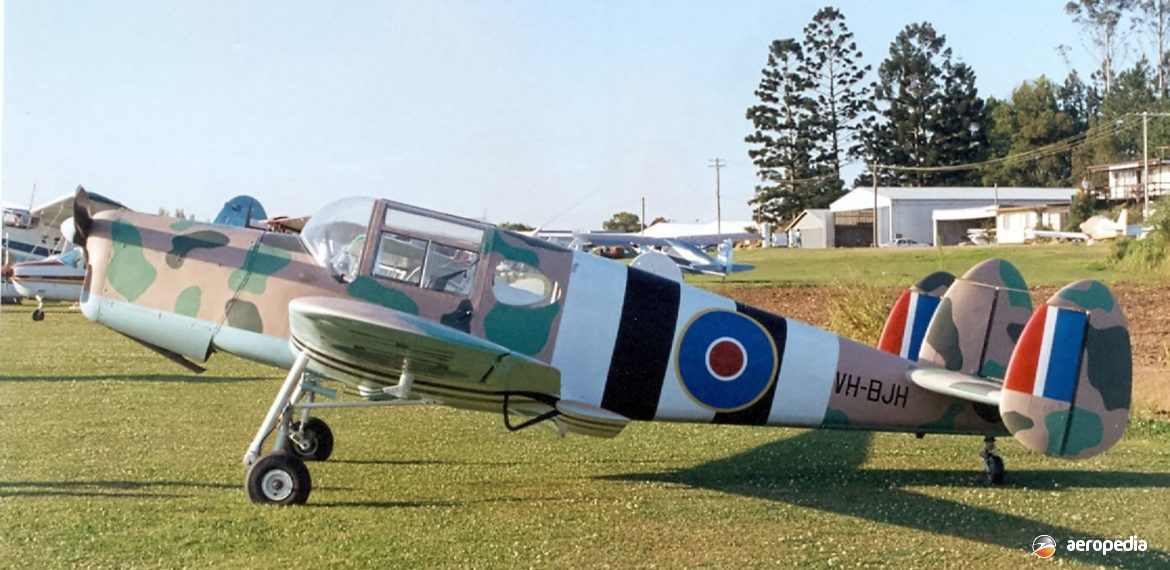Photograph:
Miles Messenger VH-BJH (c/n 6372) at Murwillumbah, NSW in 1993 (David C Eyre)
Country of origin:
United Kingdom
Description:
Four-seat cabin monoplane
Power Plant:
[Mk 2A] one 116 kw (155 hp) Blackburn Cirrus Major 3 four-cylinder in-line air-cooled engine;
[Mk 4A] one 108 kw (145 hp) de Havilland Gipsy Major 1D four-cylinder in-line air-cooled engine
Specifications:
- Wingspan: 11 m (36 ft 2 in)
- Length: 7.3 m (24 ft)
- Height: 2.3 m (7 ft 6 in)
- Wing area [Mk 4A]: 17.7 m² (191 sq ft)
- Max speed: 193 km/h (120 mph)
- Cruising speed: 183 km/h (112 mph)
- Stalling speed at sea level: 45 km/h (28 mph)
- Initial rate of climb: 355 m/min (1,100 ft/min)
- Service ceiling: 5,185 m (17,000 ft)
- Take-off run: 55 m (180 ft)
- Landing run: 55 m (180 ft)
- Range: 740 km (460 miles)
- Empty weight: 658 kg (1,450 lb)
- Loaded weight: 1,089 kg (2,400 lb)
History:
Developed during World War II as a liaison aircraft for the RAF, the prototype of the Miles M.38 Messenger series (U-0223) was flown for the first time on 12 September 1942 at Woodley, UK. A small number of the type was then built for the RAF as the Messenger I fitted with the Gipsy Major 1D engine. After the war these aircraft were declared redundant for RAF purposes, and most were offered for disposal. Eighteen became private aircraft and were placed on civil aircraft registers with the new designation Mk 4A. At the end of World War II production continued for the civil market, and the aircraft built were known as the Mk 2A. These could be distinguished by their oval instead of square rear windows, and Cirrus Major 3 engines in place of the Gipsy Major 1D. Production of the 2A concluded on 1 January 1948 after 60 examples had been built.
One Mk 3 was built (U-2047), and was first flown during the war with fully retractable flaps. Subsequently it was registered to Miles Aircraft as G-AGOY. It was then taken to Zurich as an air-taxi, and finally was flown in Ireland. The Mks 4 and 4B were variants fitted with Gipsy Major 10 engines.
The Messenger was constructed of wood. The fuselage was built up from longerons, stringers, and U-frames, covered with a plastic-bonded plywood skin, through which passed the twin-box spars of the one-piece, plywood-covered mainplane. Miles non-retractable auxiliary aerofoil flaps were fitted, and single-strut undercarriage legs were designed to withstand heavy landings. The Mks 2B and 2C were special aircraft which were used as test-beds for various types of engines; and one Mk 2A (G-AILI) was fitted with a Czech Praga E eight-cylinder engine providing 112 kw (150 hp), this engine being fitted experimentally due to a shortage of engines..
Messenger Mk 2As which have been registered in this region over the years included: c/n 6340 (ex-G-AIDH) registered VH-ALN in February 1952 and damaged beyond repair in an accident in 1959; c/n 6373 (ex-G-AJKG) registered VH-AVQ in December 1953 which was stored after retiremen, has been restored and placed on static display at the Moorabbin Air Museum, VIC; c/n 6372 (ex-G-AJVL) registered VH-BJM in December 1950, c/n 6376 (ex-G-AKAI) registered VH-AVD in July 1950 and withdrawn from service in April 1967; and c/n 6717 (ex-G-AKKL) registered ZK-AWE in October 1950 and withdrawn from service in July 1970.
Messenger Mk 4As included: c/n 6350 (ex RH377, G-ALAF) registered ZK-BED in February 1954 and withdrawn from service in July 1970 and c/n 4702 (ex RH376, G-ALBP) registered VH-WYN in April 1955. Messenger Mk 4 c/n 6343 (ex G-AIRY) was registered to the Canterbury Aero Club in April 1950 as ZK-ATT and withdrawn from service in July 1970. It survives in storage at Rotorua.
Five of the six Australian-registered aircraft, all that remained airworthy at that time, were withdrawn from service in 1963 due to the policy of the Department of Civil Aviation concerning the glue used in the wings at the time of construction. VH-ALN is believed to be in storage in Melbourne. VH-WYN was on display at Airworld, Wangaratta, VIC for some years but was later sold following the closure of the museum; it is believed to be in storage awaiting restoration.
As noted above, VH-AVQ is on display at the Moorabbin Aircraft Museum; and VH-BJH (c/n 6372), a Mk IIA, was restored to airworthiness in the mid 1990s in Queensland and for a period was based at Goulburn, NSW, being finished in RAF camouflage with the serial RG383. Later it was sold, the registration being changed to VH-ZZM. In 2004 it was sold and exported to New Zealand where it became ZK-CMM with Mr David Cowie of Auckland. After the demise of its owner it was loaned to and operated by NZ Warbirds of Auckland, the registration being changed to ZK-CMM.

